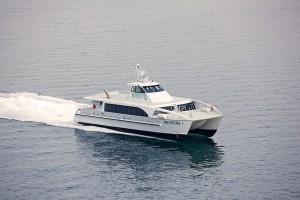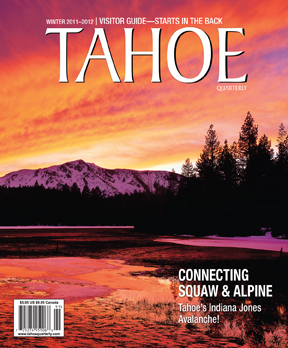North-South Water Transit Proposed for Lake Tahoe
Written by Dylan Silver
In the early twentieth century, getting to, from and around The Lake may have been easier and more environmentally friendly. With trains, ferries, foot and car access to the area, it was certainly more multimodal, says Alfred Knotts, a transportation project manager with the Tahoe Transportation District (TTD).
“We kind of joke that Lake Tahoe had a better transportation system 100 years ago than it does today,” Knotts says.
With a new ferry project in the works, TTD officials hope to make some headway on their goal to get people out of cars. Connecting the North Shore and South Shore via water makes a lot of sense, Knotts says.
“This is an environmentally friendly, economically sound and beneficial way of breaking the geographical barrier when it comes to traveling around Lake Tahoe,” he says. “It’s the equivalent to a light rail system with Lake Tahoe as the tracks and marinas serving as the depots.”
But the passenger ferry project still has a lot of Lake Tahoe’s bureaucratic maze to run. It’s already stirring up opinions from locals and visitors. Many applaud the effort to reduce the number of vehicle miles driven in the area. Some question the project’s sustainability, while others lament the boat’s big wake. One thing’s for sure: With a proposition this large, nearly everyone in Lake Tahoe has something to say.
“I have some serious concerns about the ferry,” says South Lake Tahoe city councilman Tom Davis. “I am still opened minded. I want to see the numbers, but it is very costly to run boats back and forth across The Lake.”
The project, including pier upgrades, is estimated to cost $33 million with an annual operating cost of $3 million. The start-up cost would be entirely covered by federal grant money, while a mix of state and federal dollars would pay for the operation, according to TTD documents. If planning goes smoothly, service could start as early as summer 2016 between Tahoe City and South Lake Tahoe.
This is not The Lake’s first go-around with passenger ferries. According to documents in the Bliss Family Collection, the luxurious 169-foot steamship Tahoe—the original “Queen” of The Lake—carried passengers from Glenbrook to Tahoe City for more than four decades before it was scuttled near the East Shore in 1940.
Though some smaller ferries may have operated in the mid-1900s, the automobile became the primary mode of transportation around Lake Tahoe as roads began to expand. In the 1950s, plows began clearing the passes to Lake Tahoe in the winter, allowing year-round access. In 1957, the dual tunnels through Cave Rock were completed to ease the bottleneck of traffic from Nevada. The wildest illustration of the car’s importance at The Lake was the proposition to build a four-lane freeway around the West Shore, which would have included a bridge over Emerald Bay.
“My sense is that after World War II, the car was king and people drove around The Lake and to wherever they were going,” says Lake Tahoe historian David Antonucci. “Waterborne transit would have been slow, expensive and inefficient.”
Today, runoff from roads, urban centers and air pollution is largely charged with the decline of Lake Tahoe’s clarity. To reduce the ultra-fine particles accumulating on roads and in the air—which eventually end up in the water—TTD officials want to reduce dependence on private cars.
The proposed ferry could carry anywhere from 120 to 200 passengers and make up to 12 trips daily. The transit across The Lake would take approximately 25 minutes—20 minutes faster than driving—and cost around $8 each way, according to TTD. Knotts would like to see passengers be able to bring their bikes, paddleboards, skis and other toys on the trip.
While the service would simplify regional travel, it could also prove to be an attraction in itself.
“The water transit will connect the South and North shores in a truly unique fashion that will create a new synergy for the Basin as a whole,” says Carol Chaplin, executive director of the Lake Tahoe Visitors Authority. “The visitor attraction to the service is undeniable and it would really differentiate our destination.”
While excursion boats like the Tahoe Queen and M.S. Dixie II have found success operating on The Lake, running a year-round shuttle that qualifies for federal transportation funding is another ball game. Knotts has studied other ferry operations extensively. He visited the Seattle area to learn about the Rich Passage Ferry, which would provide the model for the Lake Tahoe boats. Still, there are doubts about the sustainability.
“I have not seen the demand for this service from the Tahoe Transportation District. I am not optimistic,” Davis says. “A couple of private enterprises have tried to do it and it didn’t work, particularly in the winter.”
Extensive work is necessary before the boats launch. The terminals in Tahoe City and South Lake Tahoe would need extensive retrofitting to meet criteria for ferry service. The environmental impact statement is expected in 2015. And, the boats themselves need to be built.
So far, the public has showed support, with some reserve. TTD received more than 100 comments, emails and phone calls during the proposal’s open comment period late last year. Going forward, that’s what Knotts would like to see more of.
“This is really the time for the public to get involved and inquire about the project,” he says. “We’ll be having a lot of meetings and workshops this spring and summer.”







